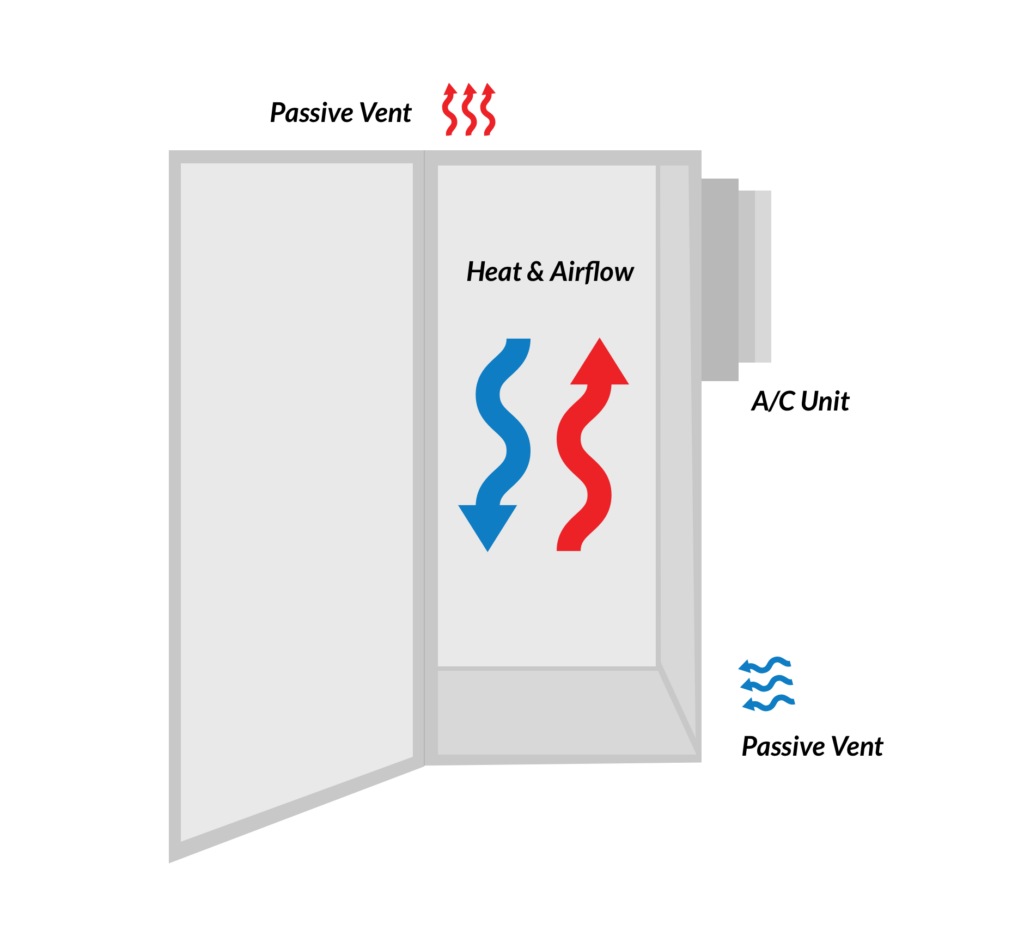Optimal Airflow in Electronic Enclosures; and 4 Design Tips
Thermal management for sophisticated electronics in protective enclosures starts with one fundamental element: airflow. Optimal airflow in electronic enclosures, both within and throughout, can mean the difference between successfully maintaining and cooling your sensitive components and risking costly downtime associated with failures.
Equipment has specific operating temperature ranges and when put inside of cabinets and enclosures, temperature can become a big issue. Cooling should be considered early in the design process, but having an effective cooling strategy can help in adequately dealing with heat dissipation.
First: Understanding Heat Transfer
Heat transfer takes place in three ways: through radiation, conduction and natural or forced convection.
Heat transfer via radiation occurs through electromagnetic waves, similar to the sun’s energy reaching the earth.
Heat can also be transferred through conduction between objects. A common example of this is a microprocessor chip cooled using a heat sink, making direct contact with the chip.
Most systems remove heat through a combination of methods. Going back to the microprocessor chip, it may be cooled using a heat sink (conduction) that includes a fan (forced convection).
The most commonly used cooling methods for enclosures, in order of increasing cost, are natural convection, forced convection and air conditioning.
Second: Understanding Airflow
Natural Convection

This is the most basic form of airflow. When heat rises, cold air is pushed to the bottom of a space. If convection isn’t properly addressed, a hot spot will form at the top of the enclosure.
Natural convection cooling is adequate for most applications that generate mild heat. But, an easy solution is passive ventilation, or louvres.
Louvres are open, unfiltered vents positioned to allow ambient air to be drawn into the enclosure through openings positioned low on the enclosure surface, and to exit through similar openings positioned high on the same surface. They’re also a popular option because they provide some protection against dust entry.
Forced Convection
Using the same principles as described above with natural convection, forced convection adds a fan, blower or compressed air to force the warmed air through the enclosure and out through the upper vent.
Three devices are commonly used: fans, blowers and fan trays
Axial fans are typically capable of delivering high volumes of air at medium to low pressure
Blowers, or centrifugal fans, change the direction of the air, typically 90 degrees, and push the air out through a ducted system. They offer higher pressure with a lower flow.
Fan trays are used to direct airflow to hot spots when there is restricted airflow due to servers, drawers or shelves. It’s basically a chassis with a fan cooling module that can be mounted directly below the sensitive equipment or a hot spot. At A&J we’ve created a separate sub assembly that support fans with related parts such as EMI and dust filters.
Air Conditioning
For critical and thermally sensitive applications, or sealed cabinets, air conditioners provide the greatest capacity to transfer heat. Most air-conditioned cabinets are sealed with only inside air circulated inside to prevent moist air from entering and causing condensation.
Basic Airflow Calculations
For For ∆T in degrees F: Airflow (ft3/min) = BTU/hr / (1.08 × ∆ΤF) = (3170 × kW) / ∆ΤF
For ∆T in degrees C: Airflow (ft3/min) = BTU/hr / (1.95 × ∆ΤC) = (1760 × kW) / ∆Τc
Typical values for ∆Τ are 10C and 18F. Add 25 percent for a safety margin (12.5C and 23F). Note that ∆Τ represents the temperature rise over ambient air temperature. If ambient is too high, it may be difficult or impossible to maintain a safe operating temperature without air conditioning.
Design Tips for Component Placement
- Components with significant heat generation should be given extra space to exhaust the heat and allow for proper airflow around them. Place these items closer to the intake of the AC, if using.
- Components that run cooler can be stacked closer together. Airlfow is less of a requirement with these pieces because they have minimal effect on overall heat within the enclosure.
- There should be clearance to walls and doors; keeping the hotter components away from walls of the enclosure allows for better circulation of air within the space.
- When a component has an active airflow through internal fans, directing the airflow towards the AC intakes will help the cooler to perform more efficiently. It is more beneficial to get the hot air from the equipment into the AC, than it is to get the cold from the AC to the equipment.
- Special consideration should be made when components have internal fans mounted on its front panel. It is common to recess the front retma bars and/or specify a deeper door to ensure proper airflow facing the front of the rack.
Thermal Management Solutions to Consider
When planning your next project design, consider these three solutions:
- Fans – one of the oldest solutions to help boost natural ventilation. An air filter should always be used to minimize dust and debris, but ensure that the free-airflow rate (CFM) is three times grater than the calculated flow rate.
- Enclosure air conditioners – a viable option when the capacity requires over 1000 BTUH and especially beneficial if you’re operating in an environment that has wide temperature fluctuations.
- Air to air heat exchangers – a low-energy and low-maintenance solution that uses a heat pipe to absorb the heat inside the enclosure and transfer it to the outside via a phase-changing liquid under vacuum. However, it requires that the ambient air outside the enclosure be lower than the air inside.
We’re committed to helping you get the most out of our enclosure cooling options
Discuss your specific requirements with our engineers to get the most cost effective solution for your cooling needs. Get more information about configuration and placement from our experts.
